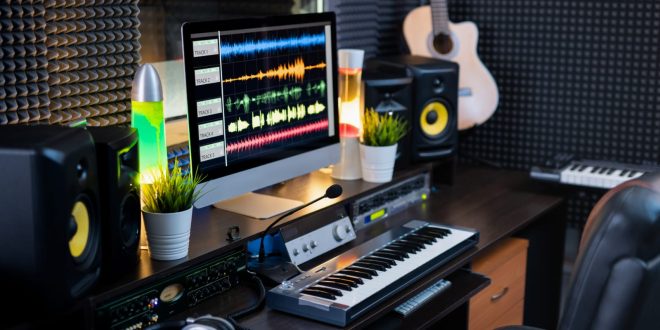Finding the best studio monitors can be a pain. There are so many options on the market, and it’s hard to tell which one will be best for you and your needs. In this article, we break down the top 5 studio monitors on the market this year based on performance and the situations they’ll be used in. So whether you’re looking for a set of budget studio monitors or the best overall studio monitors available, we’ll have an option for you. So if you’re interested in finding out which studio monitors will be best for you, stay tuned.
First up is the Neumann KH120A. The Neumann KH120A are very accurate studio monitors. They deliver rich sound with an uncolored, tight, and punchy bottom end that’s not hyped and are ideal for producing precise mixes with extraordinary detail. The KH120A is a compact studio monitor designed for use as a near-field loudspeaker. It features a mathematically modeled dispersion waveguide to deliver a smooth off-axis response, which in plain English means a waveguide designed to give a wide horizontal dispersion while limiting the vertical dispersion. The KH120s are bi-amplified using class AB analog amplifiers, delivering exceptional transient response, dynamic range, and overall output level, making these studio monitors perfect for tracking, mixing, and mastering music, broadcast audio, and post-production work. The aluminum cabinets are a reflex enclosure with two ports that are placed at the front to allow the speaker to be positioned a little closer to a wall. The drivers consist of a 5.25-inch woofer and a 1-inch titanium fabric dome tweeter. The woofer is angled slightly upwards, helping to prevent sound from being directed at and reflected up from a mixer or tabletop. Both the woofer and tweeter are powered by their own 50-watt continuous-class AB amplifier. The rear panel has four positioned bass, low mid, and high acoustic control switches that help to tailor the sound to the acoustic environment, as well as input and output level controls, an XLR input socket, and more. There’s nothing gimmicky about the KH120A’s; they’re just designed to be first-rate monitors. As with their microphones, the Neumann name is synonymous with both engineering and audio quality. The Neumann KH120A are extraordinary studio monitors with wide stereo imaging and a sweet spot that make them a great choice. They produce excellent detail, especially in the mid-range, making your job as a mixer or editor a little easier during post.
Next up is the KRK Rocket 5, our pick for the best studio monitor for the money. The KRK Rocket 5 are self-powered speakers that produce accurate, smooth sound and are perfect for mixing. Their well-thought-out design delivers a true acoustic interpretation of the mix and is the best studio monitor for the money. The KRK Rocket 5 features a 5-inch Kevlar woofer matched with a 1-inch tweeter in its bi-amped design. Like the Neumann KH120A, these monitors are active, so no external amplifiers are required. The Rocket 5 has Class D amplifiers built in, delivering 35 watts to the base driver and 20 watts to the high-frequency drivers. The onboard DSP processing can be accessed around the back, alongside balanced TRS-slash-XLR combination jack inputs, a volume rotary control, and a power button. While most people prefer the volume control at the front of the monitor because it’s easier to access, you can also control the output level by way of your DAW. In the main EQ section, you get high- and low-end frequency options with several settings for each. The best way to configure these monitors is to experiment with them to get the best and most honest sound out of them. Traditionally, you could find the ideal EQ setup by putting well-known tracks and your own well-produced mixes through the speakers and adjusting the EQ accordingly. But KRK also has a free app, KRK Audio Tools, that helps you calibrate EQ settings according to your room, among other options. Overall, it’s a nice extra to have, and it’s easier than wrestling with the dip switches found on more expensive speakers. If you’re looking for an even sound across the board with a good amount of detail in the high frequencies and a wide sweet spot, the KRK Rocket 5s are a fantastic buy for the money.
Next up is the Yamaha HS8, our pick for the best studio monitor for most people. The Yamaha HS8s deliver good value at a good price point, are perfect for studio recording and mixing, and offer incomparable clarity so that every single detail can be heard clearly. The HS8 design features an MDF cabinet covered in black vinyl. The front side of the speaker reveals a clean baffle with a driver surround at the bottom and a waveguide around the tweeter. The two-way bass reflex system produces enhanced bass, eliminating the need for a subwoofer, and is powered by a bi-amplification system that delivers 120 watts per cabinet and drives an 8-inch woofer paired with a 1-inch dome tweeter that emits high frequencies with clarity and crispness. These monitors output in the 38 Hz to 30 kilohertz frequency range to ensure that every single detail is reproduced, giving you an accurate audio image. You can expect a substantial low end that’s easy to work with and pretty revealing. Combine that with plenty of volume and limited but effective room acoustic controls, and you have a proper monitoring solution. The rear panel features standard XLR and TRS phone jack inputs, as well as room control and high trim options. The Yamaha HS8s are a no-nonsense solution for producers who want a reliable set of monitors that deliver good accuracy and are easily adaptable to most surroundings. If you’re an EDM producer or a singer-songwriter who is looking for accurate sound, you’re going to want a pair of monitors. They’re perfect for recording and mixing, as well as helping you identify problems with your mixes quickly. If you’re looking for a set of studio monitors with a high degree of accuracy, the Yamaha HS8s are a great choice. They deliver deep low-end, well-defined mids and crisp, smooth highs, and make it easy to tell if there’s something off in a mix.
Next up is the Atom Audio A7X, our pick for the best overall studio monitor. The Atom Audio A7X is one of the best studio monitors available right now and delivers an extended frequency range and detailed, balanced sound that’s ideal for music, broadcast, and post-production. The Atom Audio A7X are professional-quality studio monitor speakers that deliver high-quality audio in a compact design, making them perfect for small professional studios. Each monitor covers a frequency range of 42 Hz to 50 kHz and features a 7-inch carbon fiber RoHSL glass fiber midwoofer and a 2-inch X-Art tweeter to deliver crisp, natural audio with a wide frequency response. Each driver is powered by its own amplifier, like the Neumann KH120A, Yamaha HS8, and Rocket 5, and culminates in 150 watts of RMS of total power for strong distortion-free performance. Dual base ports on the front of the cabinet help to extend the base response. The drivers in these monitors are engineered to deliver optimized low-frequency reproduction with extended dynamic range and freedom from coloration. They incorporate a rigid yet low-mass honeycomb driver cone, a highly efficient magnet assembly, a precisely aligned voice coil, and an optimized driver chassis slash basket design. The A7X’s 7-inch woofer extends response down to 42 Hz, making the speaker a suitable choice for near-field monitoring in small to mid-sized control rooms, with or without a subwoofer. The Xart folded ribbon tweeter uses a pleated diaphragm that’s capable of moving air four times faster than the folds themselves are moving. Handcrafted to the tightest tolerances, the Xart tweeter delivers ultra-low distortion and breathtaking highs up to 50 kHz, enriching the sound field with stunning detail and faithfully conveying every nuance of the source material so you can work over periods without listening fatigue. If you’re looking for the best overall studio monitors that are compact, self-powered, and deliver strong distortion-free performance, the Atom Audio A7X is a very good choice. These monitors are designed to give you optimized low-frequency output with minimal coloration and an extended dynamic range.
Finally, we have the Mackie CRX series, our pick for the best budget studio monitor. Mackie CRX speakers are affordable bare-bone studio monitors with a focus on audio performance that make them the best budget studio monitors available. These speakers are black, with an eggshell finish covering most of the cabinet and some green trim on the front-facing panels. The front face of the powered speaker has a power-slash volume knob, and the Mackie logo lights up with a white LED when the speakers are on. The back panel of the powered speaker houses left and right TRS quarter-inch inputs as well as left and right RCA inputs and a 3.5-millimeter stereo aux input. Below these connections, there’s a switch for assigning the left or right channel to the speaker. There’s also a connection for the included speaker wire and a hard-wired power cable located next to the power switch. The system ships with a 3.5 millimeter RCA cable as well as a standard 3.5 millimeter audio cable. There’s also a 3.5-millimeter headphone jack that disables the drivers when the headphones are connected. The 0.75-inch silk dome tweeters and 3-inch polypropylene-coated woofers combine for 50 watts of power in a frequency range of 70 Hz to 20,000 Hz. On tracks with intense sub-bass content, the speakers deliver an accurate low-frequency response. With the speaker volume maxed out, some distortion is produced, which is common with studio monitors that aren’t equipped with digital signal processing to control distortion. So if your mixes deal with lots of sub-bass, you’ll likely want to go with something that’s a little more expensive, like the KRK Rocket 5, which has onboard DSP. There’s also no subwoofer output for these speakers, so what you hear is what you get. That said, for most genres, they deliver an accurate bass response; just don’t count on deep rumble. If you’re looking for a set of budget studio monitors, the Mackie CRX Series is a decent choice for the money. While the audio reproduction is accurate, there’s no DSP available to control distortion, and sub-bass frequencies aren’t supported well.



